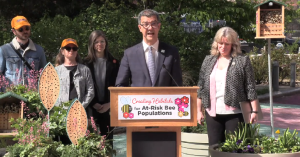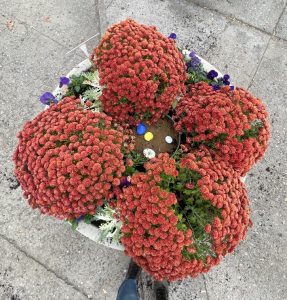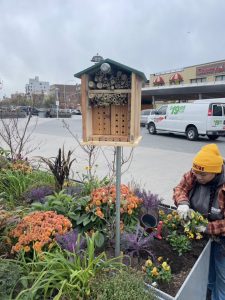
Department of Transportation
Ydanis Rodriguez, NYC DOT Commissioner, announces the launch of the Pollinator Port Project during Earth Week, highlighting the city’s commitment to supporting native bee populations.
By MOHAMED FARGHALY
mfarghaly@queensledger.com
In a bid to bolster urban biodiversity and support at-risk native bee populations, the New York City Department of Transportation (NYC DOT), in collaboration with The Horticultural Society of New York (The Hort) and Rutgers University, has launched the Pollinator Port Project.
Unveiled during Earth Week, this initiative aims to create habitats for native bees in select NYC DOT public plazas and Open Streets, deploying innovative structures like ‘bee hotels’ and ‘bee bunkers’ alongside strategic vegetation plantings.
“Bees are essential for the health of our planet, and this initiative will create habitats for at-risk native bee populations and help facilitate important scientific research,” NYC DOT Commissioner Ydanis Rodriguez said.
The Pollinator Port Project is poised to transform NYC’s bustling streetscapes into havens for bees, promoting biodiversity and ecological resilience within the city. These efforts align with the United Nations’ Environment Program’s emphasis on the critical role of bees in sustaining life and biodiversity.
“We are thrilled to work with DOT to support bringing pollinators to NYC public plazas and open streets, and to share more with New Yorkers about the pollinators that help their green public spaces thrive,” stated Georgia Faulkner, senior director of partnerships, programming, and public space at The Horticultural Society of New York.
The project’s scientific underpinning comes from Rutgers University’s expertise, led by Dr. Kimberly N. Russell. By integrating science and design, the team is crafting habitats – Bee Bunkers and Bee Barrels tailored to meet the specific needs of native bee populations.
“Most bee species cannot live in hives, so we need to give them other materials to build their homes,” Russel said. “Our hope is that these Pollinator Ports connect green spaces, giving bees the resources, they need to move around the city and pollinate our flowers.”
The initiative also carries significant educational and community engagement components. The Hort, known for its commitment to greening urban spaces, will oversee the installation and maintenance of these habitats across the city. Additionally, Rutgers University will conduct research on the movement and behavior of bees in urban environments, fostering a deeper understanding of their ecological significance.

Department of Transportation
Bee Bunkers: Burrowing bees find refuge in these protected soil chambers, providing safe nesting grounds for their eggs until spring.
This groundbreaking project has garnered support from various stakeholders, including the Ittleson Foundation, which provided a $50,000 grant to Rutgers for the first three years of the study.
The Pollinator Port Project will encompass several NYC DOT plazas and Open Streets, including Parkside Plaza and Gates Ave in Brooklyn and 34th Ave in Queens.
Bee hotels, resembling birdhouses filled with natural materials like reeds and bamboo, offer ‘rooms’ for solitary bees to nest and rest, where female bees lay eggs and provide food for developing larvae. These hotels will be strategically placed in planted areas of public plazas and Open Streets, facilitating bee movement across boroughs.
Alternatively, bee bunkers provide protected soil for female bees to build nests and lay eggs, ensuring the safety of developing larvae until spring. Burrowing bees, known for their docile nature, tend to forage within a few blocks of their habitat. These bunkers will be situated within existing planters to minimize interactions with people.
Anthony C. Wood, executive director of the Ittleson Foundation, lauded the initiative, stating, “Turning public plazas and open streets into habitat for at-risk bees is brilliant and exactly the type of innovative environmental model we love to support.”
Mackenzie Pitt, Communications Manager at the Horticultural Society of New York, sheds light on the collaborative effort behind the Pollinator Port Project, which seeks to create havens for at-risk native bee populations within the urban expanse of New York City. The initiative, born out of a partnership between Rutgers University, The Hort, and the NYC Department of Transportation (DOT), aims to address the pressing need for habitats that support pollinators, particularly native bee species, in the city’s concrete jungle.
“The polio project is a collaboration of Rutgers, the Horticultural Society, and DOT, made possible by a grant from the Ittleson Foundation,” Pitt explains. “It’s both a research and a social experiment and that there’s never been this form of installing the habitats for native bees in this way. It’s all about creating.”
Pitt underscores the significance of these habitats for native bee populations, emphasizing their role in sustaining the city’s ecological balance.
“These native species are the ones that take care of our native flora and allow for humans to benefit from all the needs and benefits we get from plants, particularly our native plant species,” Pitt said.
With New York City’s landscape predominantly characterized by concrete, the provision of suitable habitats becomes imperative to prevent the decline of these essential pollinators.
Reflecting on the project’s origins, Pitt highlights The Hort’s mission to “green the in-between,” bringing verdant spaces to unconventional urban locales. Through their partnership with DOT and community engagement initiatives, The Hort has been instrumental in maintaining green spaces in various neighborhoods across the city, laying the groundwork for the Pollinator Port Project.
The project’s expansion underscores a broader commitment to enhancing green spaces and fostering ecological resilience in urban environments. By harnessing the power of collaboration and innovation, NYC aims to become a beacon for biodiversity conservation and sustainable urban development.

Department of Transportation
Bee Hotels: Resembling birdhouses, these structures offer solitary bees ‘rooms’ to nest and rest, aiding in the conservation of native bee populations in urban environments.



































